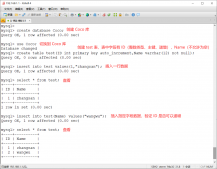1、预编译的好处
大家平时都使用过JDBC中的PreparedStatement接口,它有预编译功能。什么是预编译功能呢?它有什么好处呢?
当客户发送一条SQL语句给服务器后,服务器总是需要校验SQL语句的语法格式是否正确,然后把SQL语句编译成可执行的函数,最后才是执行SQL语句。其中校验语法,和编译所花的时间可能比执行SQL语句花的时间还要多。
如果我们需要执行多次insert语句,但只是每次插入的值不同,MySQL服务器也是需要每次都去校验SQL语句的语法格式,以及编译,这就浪费了太多的时间。如果使用预编译功能,那么只对SQL语句进行一次语法校验和编译,所以效率要高。
2、MySQL执行预编译
MySQL执行预编译分为如三步:
- 执行预编译语句,例如:prepare myfun from 'select * from t_book where bid=?'
- 设置变量,例如:set @str='b1'
- 执行语句,例如:execute myfun using @str
如果需要再次执行myfun,那么就不再需要第一步,即不需要再编译语句了:
- 设置变量,例如:set @str='b2'
- 执行语句,例如:execute myfun using @str
通过查看MySQL日志可以看到执行的过程:

3、使用Statement执行预编译
使用Statement执行预编译就是把上面的SQL语句执行一次。
|
1
2
3
4
5
6
7
8
9
10
11
12
13
14
15
16
17
18
19
20
21
22
23
24
25
|
Connection con = JdbcUtils.getConnection();Statement stmt = con.createStatement();stmt.executeUpdate("prepare myfun from 'select * from t_book where bid=?'");stmt.executeUpdate("set @str='b1'");ResultSet rs = stmt.executeQuery("execute myfun using @str");while(rs.next()) { System.out.print(rs.getString(1) + ", "); System.out.print(rs.getString(2) + ", "); System.out.print(rs.getString(3) + ", "); System.out.println(rs.getString(4));}stmt.executeUpdate("set @str='b2'");rs = stmt.executeQuery("execute myfun using @str");while(rs.next()) { System.out.print(rs.getString(1) + ", "); System.out.print(rs.getString(2) + ", "); System.out.print(rs.getString(3) + ", "); System.out.println(rs.getString(4));}rs.close();stmt.close();con.close(); |
4、useServerPrepStmts参数
默认使用PreparedStatement是不能执行预编译的,这需要在url中给出useServerPrepStmts=true参数(MySQL Server 4.1之前的版本是不支持预编译的,而Connector/J在5.0.5以后的版本,默认是没有开启预编译功能的)。
例如:jdbc:mysql://localhost:3306/test?useServerPrepStmts=true
这样才能保证mysql驱动会先把SQL语句发送给服务器进行预编译,然后在执行executeQuery()时只是把参数发送给服务器。
|
1
2
3
4
5
6
7
8
9
10
11
12
13
14
15
16
17
18
19
20
21
22
23
24
25
|
Connection con = JdbcUtils.getConnection();String sql = "select * from t_book where bid=?";PreparedStatement pstmt = con.prepareStatement(sql);pstmt.setString(1, "b1");ResultSet rs = pstmt.executeQuery();while(rs.next()) { System.out.print(rs.getString(1) + ", "); System.out.print(rs.getString(2) + ", "); System.out.print(rs.getString(3) + ", "); System.out.println(rs.getString(4));}pstmt.setString(1, "b2");rs = pstmt.executeQuery();while(rs.next()) { System.out.print(rs.getString(1) + ", "); System.out.print(rs.getString(2) + ", "); System.out.print(rs.getString(3) + ", "); System.out.println(rs.getString(4));}rs.close();pstmt.close();con.close(); |
5、cachePrepStmts参数
当使用不同的PreparedStatement对象来执行相同的SQL语句时,还是会出现编译两次的现象,这是因为驱动没有缓存编译后的函数key,导致二次编译。如果希望缓存编译后函数的key,那么就要设置cachePrepStmts参数为true。例如:
jdbc:mysql://localhost:3306/test?useServerPrepStmts=true&cachePrepStmts=true
|
1
2
3
4
5
6
7
8
9
10
11
12
13
14
15
16
17
18
19
20
21
22
23
24
25
26
|
Connection con = JdbcUtils.getConnection();String sql = "select * from t_book where bid=?";PreparedStatement pstmt = con.prepareStatement(sql);pstmt.setString(1, "b1");ResultSet rs = pstmt.executeQuery();while(rs.next()) { System.out.print(rs.getString(1) + ", "); System.out.print(rs.getString(2) + ", "); System.out.print(rs.getString(3) + ", "); System.out.println(rs.getString(4));}pstmt = con.prepareStatement(sql);pstmt.setString(1, "b2");rs = pstmt.executeQuery();while(rs.next()) { System.out.print(rs.getString(1) + ", "); System.out.print(rs.getString(2) + ", "); System.out.print(rs.getString(3) + ", "); System.out.println(rs.getString(4));}rs.close();pstmt.close();con.close(); |
6、打开批处理
MySQL的批处理也需要通过参数来打开:
rewriteBatchedStatements=true
以上就是一文搞懂MySQL预编译的详细内容,更多关于MySQL预编译的资料请关注服务器之家其它相关文章!
原文链接:https://www.cnblogs.com/gdwkong/p/7635541.html

















